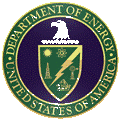United States Department of Energy

United States Department of Energy: Publications
Date of this Version
2012
Citation
Environ. Sci. Technol. 2012, 46, 7992−8000
Abstract
Etched silicon microfluidic pore network models (micromodels) with controlled chemical and redox gradients, mineralogy, and microbiology under continuous flow conditions are used for the incremental development of complex microenvironments that simulate subsurface conditions. We demonstrate the colonization of micromodel pore spaces by an anaerobic Fe(III)-reducing bacterial species (Geobacter sulfurreducens) and the enzymatic reduction of a bioavailable Fe(III) phase within this environment. Using both Xray microprobe and X-ray absorption spectroscopy, we investigate the combined effects of the precipitated Fe(III) phases and the microbial population on uranium biogeochemistry under flow conditions. Precipitated Fe(III) phases within the micromodel were most effectively reduced in the presence of an electron shuttle (AQDS), and Fe(II) ions adsorbed onto the precipitated mineral surface without inducing any structural change. In the absence of Fe(III), U(VI) was effectively reduced by the microbial population to insoluble U(IV), which was precipitated in discrete regions associated with biomass. In the presence of Fe(III) phases, however, both U(IV) and U(VI) could be detected associated with biomass, suggesting reoxidation of U(IV) by localized Fe(III) phases. These results demonstrate the importance of the spatial localization of biomass and redox active metals, and illustrate the key effects of pore-scale processes on contaminant fate and reactive transport.

